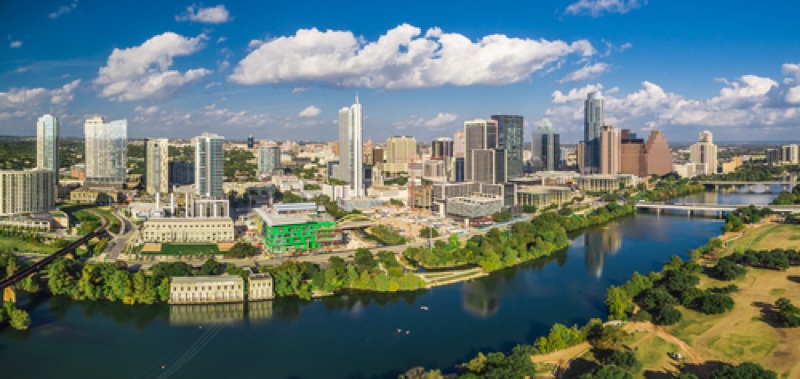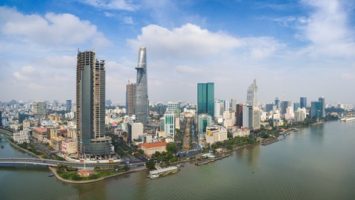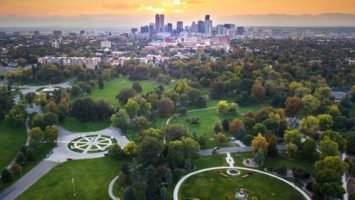
By Steve Guengerich
I believe Smart Cities are products of both nature and nurture, just like smart people. Think back to smart people you know. Some people just seem to be blessed from birth with more gray matter, a quicker mind, and better memory retention than the rest of us. But superior natural gifts are wasted when lacking guidance, discipline, and a purpose that shapes their intellectual horsepower towards some greater purpose.
What Makes Smart Cities
Likewise, smart cities. Some places are blessed with good weather, crucial natural resources like water, and a topography that accommodates being settled and built upon.
Austin is one of these places.
It has good weather throughout the year and is situated in a location that avoids most of the major forces of natural disaster, like hurricanes, tornadoes, earthquakes, snowstorms, and the like. The Colorado river, that runs through Austin, is an abundant source of fresh water supplying the city. Its future was further ensured with construction of the highland lakes system of dams and lakes, built in the early part of the 20th century and managed by the Lower Colorado River Authority (LCRA). And, the Austin topography has accommodated plenty of land settlement and construction for decades, with plenty of trees, natural streams and lakes, and malleable soil. But, all of these natural advantages that Austin possesses would be for naught without the nurture of leadership, a vision for the future, and the community planning to get there.
Vision and Planning
In its recent history, I’ve observed Austin traversing at least three major cycles of this vision-planning activity, with each carrying the city forward to the next, higher place on the global stage. It seems like these cycles come roughly once every 15 years. They say that a generation is approximately 30 years. So, perhaps the city vision-planning cycle hits every generation in its prime, at least twice: once to inaugurate the new generation, and a second time, to let that generation orient the new one coming after it.
The first cycle of Austin’s smart city future to my memory was in the mid- to late-1980s. Austin was in the depth of a land speculation recession, which put a damper on much of the traditional economy. But, it was also the big winner in a national contest to locate a major federal technology initiative, called the Microelectronics & Computer Technology Corporation (MCC). MCC became one of the anchors of a new, digital sector for Austin, which became referred to as the “technopolis” by the IC2 research group at The University of Texas at Austin.
Organic and Institutional Efforts
As MCC’s mission evolved and people came and went, Austin began to benefit by having new tech-oriented companies surface in software, hardware, communications, semiconductors, and services. By early 2000, as the dot com era had firmly taken hold, it was time for a new burst of vision-planning.
Organically, the new, colorful generation of dot com founders claimed a role in this vision-planning through ventures like the series of 360 Summits that brought together diverse groups of business, academic, political, and civic leaders to engage in deep discussions about Austin’s future. Initiatives like Charitech, the IDEA Network, and the Entrepreneur’s Foundation were formed during this period, to provide on-going vehicles for business-civic action.
The early 2000s were also the time when a broad, community-wide effort, called Envision Central Texas, was launched to chart a vision and plan for all stakeholders. I vividly remember participating in one of several planning sessions to which Austin citizens, young and old, were openly invited to participate in an active, hands-on design session. It was incredibly exciting, energizing, and bonding for everyone. It made you feel like you were having a direct hand in planning the future of your city.
Outcomes and Impact
Of all of the outcomes of Envision, the one that had the greatest impact on the next 15 years of Austin growth was the much greater emphasis on denser development in key clusters of residential, commercial, and retail real estate activity. This included downtown Austin, the Domain, and the Mueller-Airport development.
Now, 15 years later, Austin is coming off of another burst of smart city planning, let by the Imagine Austin comprehensive planning process, charting a vision for the city for the next twenty years.
The city’s participation in the “Beyond Traffic” Smart City Challenge is directly aligned with the Imagine Austin plan. The goal is to build a fully integrated, first-of-its-kind transportation network that uses data, technology, and creativity to shape how people and goods move in the future.
It is aspirational vision like this, providing a purpose that we can all share, that drive the creation of great cities. Austin is one. Nature and nurture created it. Other smart cities (just like smart people) are created and sustained in the same way.
About Steve Guengerich
Steve Guengerich is a life-long entrepreneur and award-winning author, whose newest book, Naturally Caffeinated: Addicted to Entrepreneurship, is available at bit.ly/ncthebook. He is the Managing Director of BroadBrush Ventures LLC, a Principal with Powershift Group, and an Adjunct Professor at St. Edward’s University. Among his many community roles, Steve has served as a member of the Austin Museum of Arts, Austin Social Venture Partners, and Capital Area Workforce Development boards of directors, CEO of Easter Seals of Central Texas, and founder & chairman of Knowbility.


